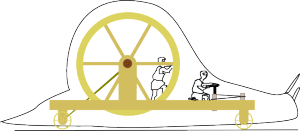As part of the project on Hero of Alexandria and his Theatrical Automata, I’ve been looking at the history of automata in Greek and Roman antiquity. As well as Hero’s treatise, there are occasional brief references to devices that may (or perhaps may not be) automata. The evidence is tantalising and gives hints about how and where such devices were displayed and used. Attempts to interpret such automata also show the perils of modern assumptions when it comes to evaluating ancient science and technology.
Perhaps the most well known and certainly the most bizarre example of ancient automata is a giant snail that Demetrios of Phaleron is supposed to have displayed at the Dionysia festival in Athens, apparently in 308 BC when he was archon. The tale is told at second hand by Polybios, the great Hellenistic historian (12.13.7–12), but it goes back to the Attic orator Demokhares, an enemy of Demetrios and the Macedonian rule that he represented. Demokhares is said to have attacked Demetrios for his arrogance and bombast and to have given various rationales including this:
because a snail moving of its own accord preceded him in the procession, spitting out slime, and donkeys processed together with them through the theatre.
Some aspects of this scenario are less weird than they might at first sight appear. Although the Dionysia festival is most well known for its performances of tragedy and comedy, many other things happened including a procession on the first day of the festival and various acts of political theatre. So it is far from implausible that the political strongman of the day used the festival as the context for self-aggrandising display. Such performance of automata at festivals is also by far the most common context in which we find self-powered devices in antiquity (although not the only one). And donkeys (if the text is right) are not unknown in processions. But still: a snail? Spitting?
You might think that this device, however intriguing, is hardly described in enough detail to allow modern writers to reconstruct it. But you would be wrong. In 1937, Alfred Rehm proposed the following scheme. The snail would be 3–4m high, powered by an internal treadmill that powered two rear drive wheels; a single front wheel rotated in a kind of fork and was steered; there would be a two man crew, one on the treadmill, one steering. See fig. 1, which is based on Rehm’s plan.

This reconstruction is a triumph of informed speculation, but undoubtedly bogus. It is worth asking why. Rehm’s ostensible starting questions are i) why choose to represent a snail, ii) how could an automaton travel from the Academy, well outside the city walls, where the procession started, to the Theatre of Dionysos, 3km away. But the proposed configuration draws heavily on other pieces of speculative reconstruction—of ancient military technology.
Treadmills are known from antiquity, but powered by oxen and driving cranes (as on the Haterii relief). Rehm draws the inspiration for his version of the snail from Erwin Schramm’s reconstruction of the siege tower (helepolis) constructed for Alexander the Great by Poseidonios and described by the Hellenistic writer on siege machinery, Biton (their edition published in 1929). Schramm, sometime General in the Imperial German Army and undoubted pioneer in research on ancient artillery and siege machinery, proposed that this tower was powered by an internal treadmill. There’s actually no mention of a treadmill in Biton, who mentions a winch or capstan used to ‘help the wheels’ (p.55W). The treadmill is introduced by ingenious emendation. In fact, Biton goes on to say that the siege tower was dragged into position (p.56W). Amongst the many problems with this reconstruction, critics have pointed out that the belt drive is elsewhere unattested in antiquity (in Hero’s automata, the ropes around axles are unwound). Above all there is the problem of weight, both in terms of friction and in terms of the load on the axles. This has not prevented Schramm’s reconstruction persisting or even being elaborated by enthusiasts (see this helpful thread on a Roman army forum).
The steering gear is based on a recommendation by the mechanical writer Athenaeus, around two centuries later, to have some kind of steering gear in siege machinery (pp. 33–5W), although his explanation is, to say the least, minimal—and the diagrams in the manuscript are positively unhelpful. Again Rehm employs creative emendation and interpretation to come up with something looking satisfactorily modern. If you consider fig. 1 again, it is perhaps no accident that his article is entitled ‘Antike “Automobile”’ (Philologus 1937).
Looking for parallels in ancient military hardware is not unreasonable. Mechanical writers such as Ktesibios, Philo and Hero all wrote on both artillery and automata. Hero specifically notes that some of the mechanisms in his automata are related to those in ancient artillery (catapults). The problem here lies partly in a cavalier approach to the evidence, partly in technical plausibility, but above all the imposition of modern perspectives and assumptions on the ancient. Despite Rehm’s protestations that it is entirely coincidental, his configuration of the snail looks suspiciously like that of contemporary rear-wheel drive. The steering device is explicitly modelled on the front fork of a bicycle. And Rehm’s comparison with tanks is a bit of a giveaway. Schramm’s military background may not be entirely coincidental.
Rehm, unabashed, goes even further and proposes a similar power unit for a number of other attested automata. To take just the most implausible, from another Athenian procession, Herodes Atticus is said to have replaced the usual ox-pulled ship that figured in that procession with a huge ship with a thousand rowers powered by ‘underground machines’ (VS 2.1.5). This is not explicitly said to be an automaton, and if that suspiciously round number is accurate this ship would be huge: over five times the size of a classical Athenian trireme. Rehm suggests that this monster was powered by not one, but several internal treadmills. If this were not compounding implausibilities, consider the terrain: from the Kerameikos, through the agora, along the Panathenaic Way, up to the Areopagus near the main entrance to the Acropolis, where it moored (to be seen by the travel writer Pausanias (1.29.1) some years later). Yes: up there (fig. 2).

I don’t claim to know how Herodes Atticus managed this. I suspect that, however big the ship really was, it was winched up by external machines. As for the snail, it probably functioned in a similar way to Hero’s mobile automaton. The evidence locates the snail particularly within the theatre (i.e. the Theatre of Dionysos). A snail perhaps slightly bigger than Hero’s device (say 1.5–2m) powered by a falling weight would have sufficient range to cross the stage or the orkhēstra, particularly as the snail housing would allow for much bigger wheels than the mobile automaton’s case does. As for spitting the slime, such an effect could have been achieved straightforwardly enough, but it is not necessary to take it literally. The falling weight descends in a tube, its speed controlled by millet or mustard seeds or some other substance that empties from the bottom of the tube and leaves a trail (unless some means are taken to prevent its escape). This trail would leave an appropriate ‘slime’. The explanation for why a snail is also easy enough: wheels would be problematic for anything with obvious legs, while other creatures that crawl (e.g. snakes) offer little height for any kind of mechanism. Or indeed for any personnel: the simplest solution is to have a lightweight canvas-covered frame and someone pushing. Such a scenario is envisaged by Hero himself, who warns against making automata too big in case anyone suspects there is someone inside it.
All this remains speculation. But the more fanciful reconstructions remind us how easy it is to push our own technical and cultural assumptions onto the ancient world. There were many technical innovations in the ancient world which foreshadow modern developments (the most famous perhaps being Hero’s steam turbine), but they were not necessarily made for the same reasons as those in the modern industrial West nor were they exploited and developed in ways that might seem obvious to a modern audience. There is no straight line from ancient automata to modern clocks, cars, tanks and robots, but this does not mean that we should not take inspiration from ancient engineers or appreciate the role that their inventions played in their own societies.


Thank you for an enjoyable and informative essay.
one point–Why a snail? Polybius 12.13 says the snail was intended to mock the “slowness of the Athenians” and the snail was followed by a string of asses, to symbolize the Athenians’ “stupidity.”
Thanks for the comment. Yes that’s the allegation, but since this is coming from a hostile source, it’s unlikely to be straightforwardly true. I would understand that comment as the negative slant on the use of spectacle and display as political tools (which is how automata are used elsewhere), or (also) the two sides of the idea of “wonder-working” (thaumatopoiia), with which automata are associated. There is a problem with the asses, as the text is actually corrupt there and has variously been emended. But I’m not sure that a snail has the same kind of potential associations as asses, so I tend to the more prosaic explanation!